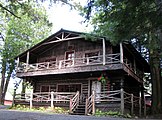Camp Pine Knot: Difference between revisions
Reverted 1 edit by Ser Amantio di Nicolao (talk): Breaks map. (TW) |
|||
| Line 2: | Line 2: | ||
| name = Camp Pine Knot |
| name = Camp Pine Knot |
||
| nrhp_type = nhl |
| nrhp_type = nhl |
||
| locmapin = New York |
| locmapin = New York Adirondack Park |
||
| image = Camp Pine Knot, Metcalf Hall.jpg |
| image = Camp Pine Knot, Metcalf Hall.jpg |
||
| caption = The "W" is for [[William West Durant]] |
| caption = The "W" is for [[William West Durant]] |
||
Revision as of 11:56, 22 June 2016
Camp Pine Knot | |
 The "W" is for William West Durant | |
| Location | Raquette Lake, NY |
|---|---|
| Built | 1877 |
| Architect | William West Durant |
| Architectural style | Adirondack Great Camp |
| MPS | Great Camps of the Adirondacks TR |
| NRHP reference No. | 86002934 |
| Significant dates | |
| Added to NRHP | November 7, 1986[1] |
| Designated NHL | August 18, 2004[2] |
Camp Pine Knot, also known as Huntington Memorial Camp, on Raquette Lake in the Adirondack Mountains of New York State, was built by William West Durant. Begun in 1877, it was the first of the "Adirondack Great Camps" and epitomizes the "Great Camp" architectural style. Elements of that style include log and native stonework construction, decorative rustic items of branches and twigs, and layout as a compound of separated structures. It is located on the southwest tip of Long Point, a two mile long point extending into Raquette Lake, in the Town of Long Lake in Hamilton County, New York.
The camp consists of some two dozen buildings, including a seven-room "Swiss Cottage", four "Log Cottages" of one to three rooms, two frame cottages of three and five rooms, a "Glass Dining Room", and a five-stall horse barn and wagon shed. Covered walkways connect many of the buildings. There was also the Barque, a 20 by 60 foot four-room bark cabin built on a log raft, used to escape from the dreaded black fly in the spring; it was fully equipped, with a kitchen, bath, and running water.
History
Pine Knot was started by Durant's father, railroad developer Thomas C. Durant, as a showplace to draw investors to Durant's holdings, but it was William West Durant that would develop it into the remarkable model for Adirondack Great Camps to follow. In 1895 West sold the camp to wealthy industrialist Collis P. Huntington.
The camp went unused from the start of the 20th century until 1947, when it was sold to the State University of New York at Cortland for 1 dollar, for use as their Outdoor Education center. Due to the soundness of its construction, despite its long disuse, the buildings required little repair. The Barque is being rebuilt.
The camp was included in a multiple property submission for listing on the National Register of Historic Places in 1986,[3] was in fact listed in 1986,[1] and was declared a National Historic Landmark in 2004.[2][4] [5]
-
William West Durant at Camp Pine Knot, 1890, Seneca Ray Stoddard
-
Durant Cabin, 2009
-
The Chalet, 2009
See also
- List of National Historic Landmarks in New York
- National Register of Historic Places listings in Hamilton County, New York
References
- ^ a b "National Register Information System". National Register of Historic Places. National Park Service. January 23, 2007.
- ^ a b "Camp Pine Knot". National Historic Landmark summary listing. National Park Service. 2007-09-11.
- ^ Gobrecht, Larry E. (July 1986). "National Register of Historic Places Inventory-Nomination: Great Camps of the Adirondacks Thematic Resources" (pdf). National Park Service.
{{cite journal}}: Cite journal requires|journal=(help) - ^ William E. Krattinger (October 2002). "National Historic Landmark Nomination: Camp Pine Knot / Huntington Memorial Camp" (pdf). National Park Service.
{{cite journal}}: Cite journal requires|journal=(help) - ^ Smith, Raymond W.; Richard C. Younken (1986 (assumed date)). "National Register of Historic Places Inventory/Nomination: Camp Pine Knot". Retrieved 2008-01-09.
{{cite web}}: Check date values in:|date=(help) and Accompanying 5 photos, undated
Sources
- Gilborn, Craig. Durant: Fortunes and Woodland Camps of a Family in the Adirondacks. Utica, NY: North Country Books, 1981.
- Kaiser, Harvey. Great Camps of the Adirondacks. Boston: David R. Godine, 1982.
External links
- SUNY Cortland Outdoor Education, "Cortland's Raquette Lake Camp Becomes First National Historic Landmark in SUNY", by Peter D. Koryzno, Winter 2004
- SUNY Cortland Outdoor Education - History of Camp Huntington (Pine Knot)
- Camp Pine Knot - The Origin of the Adirondack Great Camp
- St. Hubert's Isle - Adirondack Great Camps - Pine Knot, Uncas & Sagamore - Photos
- SUNY Cortland - Huntington Camp






